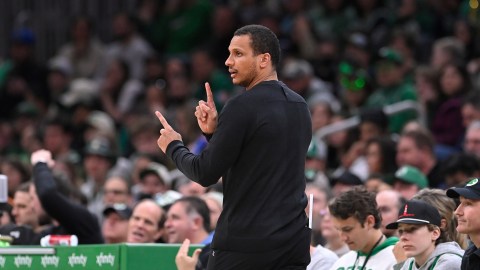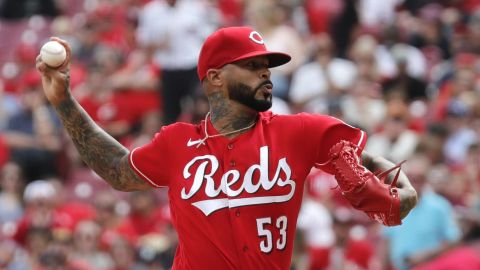After finishing eight games out of first place in the American League East and meeting their quick and painful exit from the first round of the AL playoffs, the Red Sox may need to rethink their business strategy this winter.
It's a Yankee-dominated market, and the rest of baseball is only trying to keep up. The Red Sox have tried to match the Bronx Bombers dollar for dollar before, occasionally making the megadeals needed to block the game's best players from landing in Yankee Stadium. But only occasionally. On Yawkey Way, fiscal sanity has won out more often than not.
Over the last three offseasons, we've seen general manager Theo Epstein and company employ three dramatically different rebuilding strategies. The jury's still out on which one worked best.
Strategy No. 1: Spend like madmen. After the Red Sox collapsed in August and finished third in the AL East in 2006, they were desperate to retool their roster. They were willing to overtake the Yankees by any means necessary — even if it meant drastic overspending.
The Sox went all out for Daisuke Matsuzaka. When the Seibu Lions posted him in November '06 and put his rights up for the highest bidder, the Red Sox refused to lose. They offered an unprecedented $51.1 million to talk to Matsuzaka — and then when they got through to him, they spent the next month hammering out a six-year, $52 million contract. It was a tough market for pitchers, and rather than outbid the Giants for Barry Zito, the Red Sox threw down nine figures for Dice-K.
In December of the same year, they shelled out big bucks for a new starting shortstop, offering four years and $36 million to Julio Lugo. In January, they outdid themselves, offering five years and $70 million to J.D. Drew. In a matter of three months, the Red Sox had spent well over $200 million on ensuring that third place never happened again.
It didn't.
Strategy No. 2: Do nothing at all. After the spending spree paid off and the Red Sox won the World Series in 2007, Theo shifted gears. It was an active offseason all around, with Alex Rodriguez's future in the Bronx in doubt and the Marlins making a fire sale out of Miguel Cabrera and Dontrelle Willis. But rather than make a big splash, the Red Sox stayed off the radar. They quietly re-signed World Series MVP Mike Lowell, they picked up their no-brainer annual option on Tim Wakefield, and they fielded virtually an identical team in 2008 to the one that won it all in '07.
The '08 Sox almost won it all again, but they came up short in the ALCS against Tampa Bay. Which leads us to …
Strategy No. 3: Shop in the bargain bin. The Sox were close enough to World Series glory in 2008 to taste it. They didn't need to spend the big bucks to be in contention — they were already there. So rather than make a coup of a free-agent signing like Mark Teixeira or CC Sabathia, the Sox shied away from closing on either of the big-name stars, opting instead to make small, shrewd moves that could inch them closer to winning it all.
The two poster boys were John Smoltz and Brad Penny, who added to the Sox' pitching depth for a total of $10.5 million, pocket change to pay for All-Star-quality starting pitching. But the Sox also added Nick Green for $550,000. They picked up Rocco Baldelli for an even half-million. They retooled their bullpen by adding Takashi Saito ($1.5 million), re-signing Manny Delcarmen ($476,000), and trading for Ramon Ramirez ($441,000, a considerable drop from the $5 mil they were giving Coco Crisp).
Fiscal sanity looked fantastic for the Red Sox on paper. It looked great in March, when pundits everywhere were picking the Sox to win the World Series. It looked good in July, when the team was threatening to run away with the AL East. It even looked pretty solid in October, when the clearance-sale version of the Red Sox was eight games behind the Yankees, but at least going to the playoffs.
But how does it look now?
While the Red Sox sit at home and watch this year's big-market, big-money, big-name World Series, they must be having second thoughts about their business model for this season. They're watching two teams, the Yankees and Phillies, whose payrolls this season combine for a grand total of just over just over $334 million.
Years ago, Yankees fans would proudly point out that while their team had the "Evil Empire" rep, it was the Red Sox who were the only World Series winner this century with a nine-figure payroll.
That's no longer the case. The Phillies shattered that myth last October, and either the Phils or Yankees will win it all this season with a payroll well north of the $100 million mark. It's not 2006 anymore — big money wins in baseball now.
With that in mind, it's time for the Red Sox to return to their post-2006 ways. If they want to compete with the Yankees again, they need to spend — and not just on the little guys.
Bargain-bin pickups like Smoltz and Penny will still exist in 2010. A couple of such names — think Rich Harden and Ben Sheets — are already floating around the rumor mill as potential Red Sox targets.
And that's fine. Those pitchers have clear upsides, and either one would be a good piece for the Sox' rotation next season. But just one piece isn't enough — we're talking about a much larger puzzle.
The Red Sox will need to shell out big money for Jason Bay. If they want to add another power-hitting corner outfielder as a platoon man, an injury contingency plan or a part-time DH in case David Ortiz continues his decline, they should have their checkbooks ready for that, too. Matt Holliday, Bobby Abreu and their ilk will not come to Boston cheaply. If they want to supplant Tim Wakefield from their starting rotation with a top-line starter — someone like John Lackey, perhaps — that will run them in the low eight figures, minimum.
The time for baby steps is over. The Yankees have built a monster ballclub, not just for 2009 but for the future. If the Sox want to compete, they will have to spend. It's that simple.
The bargain bin was an interesting experiment for the 2009 Red Sox. But this team has learned from both its successes and its failures — a championship is never just an impulse buy. To win it all in 2010, the Red Sox have to prove they want it.
NESN.com will be answering one Red Sox question every day in November.
Monday, Nov. 2: Are any Red Sox players untouchable in a trade?



